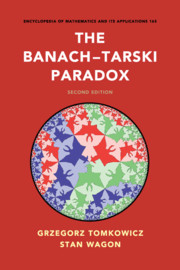Book contents
- Frontmatter
- Dedication
- Epigraph
- Contents
- Foreword
- Addendum to the Foreword
- Preface
- Part One Paradoxical Decompositions, or the Nonexistence of Finitely Additive Measures
- Part Two Finitely Additive Measures, or the Nonexistence of Paradoxical Decompositions
- 11 Transition
- 12 Measures in Groups
- 13 Applications of Amenability
- 14 Growth Conditions in Groups and Supramenability
- 15 The Role of the Axiom of Choice
- Appendices
- Bibliography
- List of Symbols
- Index
15 - The Role of the Axiom of Choice
from Part Two - Finitely Additive Measures, or the Nonexistence of Paradoxical Decompositions
Published online by Cambridge University Press: 05 June 2016
- Frontmatter
- Dedication
- Epigraph
- Contents
- Foreword
- Addendum to the Foreword
- Preface
- Part One Paradoxical Decompositions, or the Nonexistence of Finitely Additive Measures
- Part Two Finitely Additive Measures, or the Nonexistence of Paradoxical Decompositions
- 11 Transition
- 12 Measures in Groups
- 13 Applications of Amenability
- 14 Growth Conditions in Groups and Supramenability
- 15 The Role of the Axiom of Choice
- Appendices
- Bibliography
- List of Symbols
- Index
Summary
The Banach–Tarski Paradox is so contrary to our intuition that it must have some implications for the foundations of mathematics and the unrestricted use of the Axiom of Choice (AC). In this final chapter, we give a detailed account of such implications and discuss various technical points related to the use of AC. Ever since its discovery, the paradox has caused some mathematicians to look critically at AC. Indeed, as soon as the Hausdorff Paradox was discovered, it was challenged because of its use of that axiom; E. Borel [Bor14, p. 256] objected because the choice set was not explicitly defined.We address these criticisms in more detail in §15.3, but we start with several technical points that are essential to understanding the connection between AC and the paradox.
The Axiom of Choice Is Essential
The standard axioms for set theory are the Zermelo–Fraenkel Axioms; they are called ZF. When the Axiom of Choice is included, the theory is called ZF + AC, or usually just ZFC.
Results of modern set theory can be used to show that AC is indeed necessary to obtain the Banach–Tarski Paradox, in the sense that the paradox is not a theorem of ZF alone. Before we can explain why this is so, we need to introduce some notation and discuss some technical points of set theory. If T is a collection of sentences in the language of set theory, for example, T = ZF or T = ZF + AC, then Con(T) is the assertion, also a statement of set theory in fact, that T is consistent, that is, that a contradiction cannot be derived from T using the usual methods of proof. We take Con(ZF) as an underlying assumption in all that follows. Gödel proved in 1938 that Con(ZF) implies (and so is equivalent to) Con(ZF + AC); thus AC does not contradict ZF (see [Jec73, Jec78]). Let LM denote the assertion that all sets of reals are Lebesgue measurable; of course, LM contradicts AC (Cor. 1.6). Because LM implies that all subsets of each are Lebesgue measurable (see the proof of Thm. 8.17(a)), ZF + LM implies that there is no Banach–Tarski Paradox.
- Type
- Chapter
- Information
- The Banach–Tarski Paradox , pp. 296 - 312Publisher: Cambridge University PressPrint publication year: 2016

